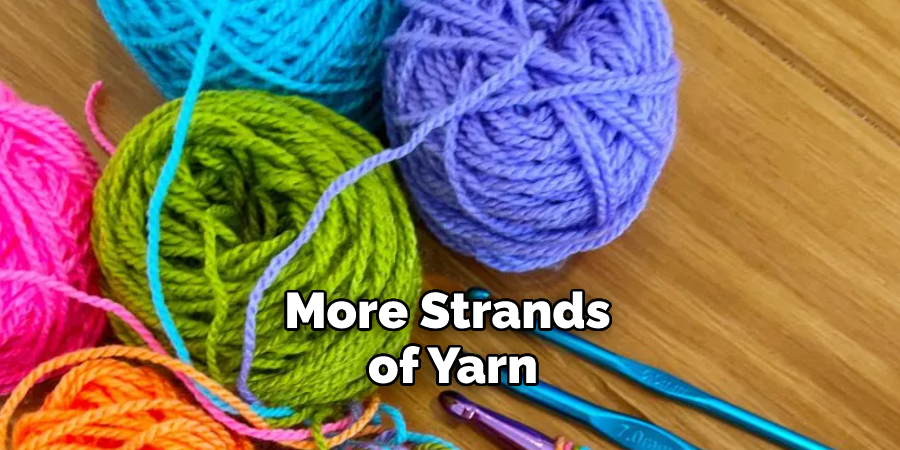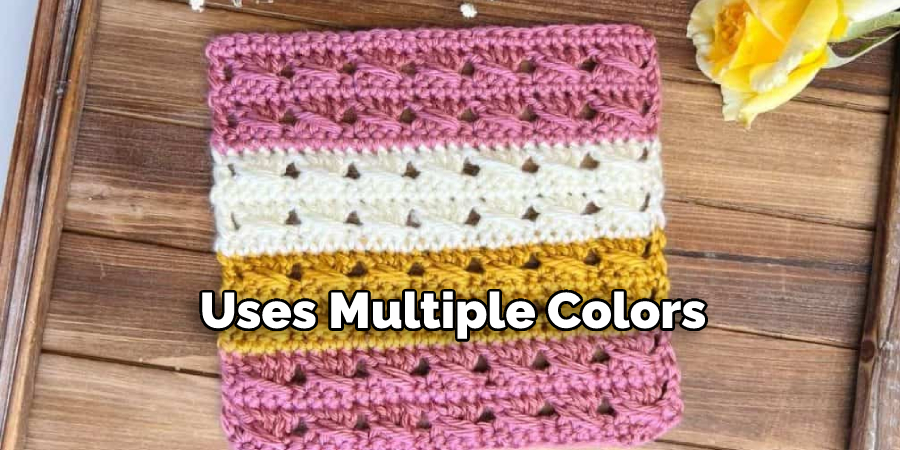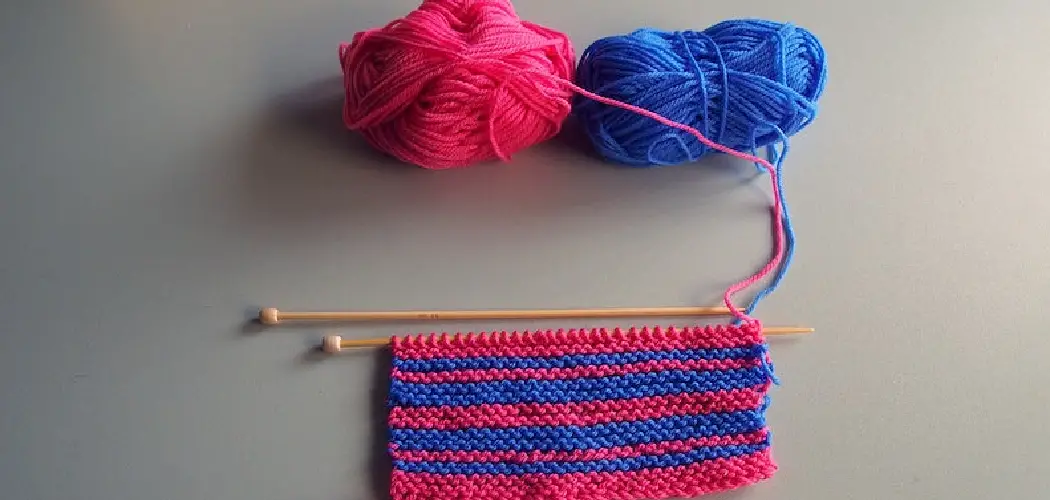Adding a second color to your crochet projects can be an exciting way to create unique and beautiful pieces. By learning the basics of two-color crochet, you can create stunning projects that are perfect for any occasion. So if you’re ready to mix two colors together and learn how to crochet with two colors, this post is for you!

Can You Crochet with Two Colors?
Yes, you can crochet with two colors! Most crocheters begin with one color at a time, but learning to work with multiple colors can open up all sorts of interesting new patterns and techniques. Working with two colors requires alternating the working yarn between each stitch or row.
This creates an interplay between the different strands, allowing you to create eye-catching stripes, checkerboard patterns, and pictures! With just two simple strategies – double crochet and single crochet – it is possible to make entire garments and home decor items out of multiple colors of yarn.
There’s no need to be intimidated by this task; anyone can learn how to use more than one color in their projects with some practice and patience.
Why Should You Crochet with Two Colors?
Crocheting with two colors offers a variety of advantages for any project. Many crocheters enjoy the beauty that adding contrasting colors to their work creates, from subtle highlights to eye-catching stripes. Another perk of dual-colored crochet is increased warmth, making it ideal for heavier winter garments that need extra insulation from the cold.
Additionally, working with multiple colors can teach you valuable skills such as color carrying and tension control. As an added bonus, crafting in various hues can help make some patterns easier to understand and, thus, faster to complete.
So why should you crochet with two colors? Bring your projects to life with extra visual appeal, stay warm in unforgiving weather, sharpen your skill sets, and save time – it’s a win-win any way you look at it!
7 Ways to Follow on How to Crochet with Two Colors
1. Changing Colors
When changing colors in crochet, it is important to remember that each stitch requires one loop of the current color yarn. Therefore, a few simple steps should be followed to make a neat transition between colors.

After completing the last stitch of the current color yarn, cut off the yarn and pull it through the last loop on the hook with a slightly longer tail than normal.
Then pick up the new color yarn and start working as usual. This will ensure that you have enough tail length for weaving in later after your project is finished.
2. Making Color Changes in Round Crochet Projects
In circular projects like amigurumi or hats, it’s important to keep track of where each round ends and starts so that your stitches line up correctly. Then, when changing colors at the end of a round, simply finish off after completing your last stitch with the previous color yarn.
Slip stitch into the next stitch with your new color yarn and continue crocheting from there until you reach the end of the round again. You can also use a marker to keep track of where each round starts and ends.
3. Tapestry Crochet
Tapestry crochet is another popular way to combine two or more colors in crochet projects, such as blankets or bags. The technique involves working multiple stitches at once by carrying one or more strands of yarn behind each stitch while crocheting using only one strand at a time.

This creates intricate designs without having to switch out colors constantly throughout a project, allowing all strands to be carried along at once until they are needed again for future stitches or rounds. Of course, it takes some practice, but tapestry crochet yields stunning results!
4. Bobble Stitch
The bobble stitch is a fun way to work with two colors in crochet projects, as it creates small three-dimensional bumps of color. To make a bobble stitch, simply insert your hook into the next stitch and pull up a loop. Then yarn over and draw through two loops on your hook.
Repeat this step four more times until you have six loops on your hook, then yarn over and pull through all loops. Switch colors after each bobble stitch are completed to create a unique pattern in your project.
5. Intarsia Crochet
Intarsia crochet is very similar to tapestry crochet, but instead of carrying the extra strands behind the work, they are worked into the stitches as needed. To make an intarsia design, start cropping with one color until it’s time to switch colors.
At that point, drop the old color, pick up the new one, and begin working with it until it’s time to switch again. This process continues throughout the project and can be used to create intricate designs.
6. Stranding
Stranding is another technique that can be used to create multi-colored designs in crochet projects. To do this, you will need to use two separate strands of yarn at once, one for each color.
You always work with the main color strand and carry the other strand along behind your project as you go, only working it into stitches when you need it for a specific design element. This technique is best suited for more experienced crocheters as it requires careful attention and skill.
7. Slipped Stitch Colorwork
Slipped stitch colorwork is a great way to combine two colors without constantly switching out yarns or carrying strands behind your work. To do this, simply slip stitch with the main color until you reach a spot where you want to incorporate the contrasting color.
Once there, make a few slipped stitches with the second color before switching back to the first one and continuing on as normal. This technique is great for creating stripes or other simple designs without carrying multiple strands of yarn at once.

By following these steps and techniques, how to crochet with two colors should be easy and enjoyable! Whether it’s tapestry crochet, bobble stitches, intarsia designs, or stranding, there are plenty of ways to combine two colors in your projects for amazing results.
Things You Need to Know Before Crochet with Two Colors
Crocheting with two yarn colors adds eye-catching interest and detail to the final project. First, however, you should know a few basic things before you begin. To prevent the colors from tangling, start each color on a separate spool and wrap it around a different finger.
Familiarize yourself with tension control: pull gently but firmly on both strands as you work to keep them even. Work over one strand when possible, or manage loops carefully if they need to cross at any point.
Finally, get comfortable with different ways of adding color, such as changing yarn on every row or crocheting stripes of different sizes. Once these basics are understood, use your creativity to create truly unique pieces!
Benefits of Crochet with Two Colors
Adding a second color to the crochet process is a great way to elevate any project. It adds visual interest and texture and can also be used to create patches of color, create shapes, or even simulate different textiles.
It has also been found that crocheting with two colors can help many beginners as each strand of yarn adds an additional layer for your hand to track, making following patterns much easier. Moreover, utilizing two colors in the process is a great time-saver as there’s no need to cut out individual pieces of fabric and stitch them manually.

With this technique, you can enjoy all the same effects while working on projects quickly and easily.
4 Common Mistakes People Make When Trying to Crochet with Two Colors
1. Not Using the Right Yarn
One of the most common mistakes people make when trying to crochet with two colors is not using the right yarn. The type of yarn you use can make a big difference in how your project turns out. For example, if you use thick yarn, your project will be much bulkier than if you use thin yarn.
Additionally, the type of fiber your yarn is made from can also affect the outcome of your project. For instance, wool yarns tend to produce more flexible projects, while acrylic yarns result in stiffer projects.
2. Not Holding the Yarn Correctly
Another mistake people often make when crocheting with two colors is not holding the yarn correctly. If you hold one color in each hand, you’ll likely end up with a tangled mess.
Instead, it’s best to hold both colors in your dominant hand and crochet over them as you work. This will help keep the yarns from getting tangled and allow you to control the tension of each color more easily.
3. Not Changing Colors at the Right Time
Another common mistake people make when working with two colors is not changing colors at the right time. In order to avoid having large chunks of one color in your finished project, it’s important to change colors every few stitches. Additionally, it’s important to carry the unused color along the side of your work so that it doesn’t get lost or tangled.
4. Not Weaving in the Ends Properly
Finally, another mistake people often make when crocheting with two colors is not weaving in the ends properly. When you finish a project that uses multiple colors, you’ll be left with a number of loose ends that need to be woven in.
If these ends are not woven incorrectly, they can come undone and ruin your finished project. To avoid this, be sure to weave each end through several stitches on the wrong side of your work before trimming it off.
You Can Check it Out to Make Paper Hydrangeas

Conclusion
Crocheting with two colors is an exciting way to add dimension and texture to your crafts! Whether it’s working in rounds or using tapestry crochet methods, combining two different hues together can yield amazing results when done properly.
With these tips and tricks in mind, you’ll be able to take your projects up a notch using multicolor techniques! Have fun experimenting! Thanks for reading our post about how to crochet with two colors.
You Can Check it Out to Make a Scarecrow Hat Out of Paper


